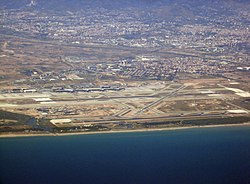El Prat de Llobregat
| El Prat de Llobregat | ||
|---|---|---|
| Municipality | ||
 |
||
|
||
| Location in Catalonia | ||
| Coordinates: 41°20′N 2°06′E / 41.333°N 2.100°ECoordinates: 41°20′N 2°06′E / 41.333°N 2.100°E | ||
| Country |
|
|
| Community |
|
|
| Province | Barcelona | |
| Comarca | Baix Llobregat | |
| Government | ||
| • Mayor | Lluis Tejedor Ballesteros (2015) (IC-V) | |
| Area | ||
| • Total | 31.4 km2 (12.1 sq mi) | |
| Elevation | 8 m (26 ft) | |
| Population (2014) | ||
| • Total | 62,866 | |
| • Density | 2,000/km2 (5,200/sq mi) | |
| Demonym(s) | pratense (Spanish), pratenc,-ca (Catalan) | |
| Website | elprat |
|
El Prat de Llobregat (Catalan pronunciation: [əɫ ˈpɾad də ʎuβɾəˈɣat]), commonly known as El Prat [əɫ ˈpɾat], is a municipality in the comarca of Baix Llobregat in Catalonia, Spain. It is situated in the delta of the Llobregat river on the right bank, bordering the coast of the Mediterranean Sea between Barcelona and Viladecans. More than a quarter of the area of the municipality is occupied by Barcelona–El Prat Airport. Apart from the transport links to the airport, the town of El Prat is served by a railway station on the coast line from Barcelona to Valencia. The municipality also has a beach and a small nature reserve at the Llac (Lake) de la Ricarda i del Remolar. El Prat is famous for its blue-legged chickens (known as gall potablava in Catalan). El Prat forms part of the metropolitan area of Barcelona.
El Prat was founded between the years 1720 and 1740, when the town started to grow besides a path crossing. The first buildings to appear were the church (dedicated to St. Peter and St. Paul), the hostel (which served as a school, bakery, and obviously as a hostel), and some other houses built by the farmers of the delta, who came to the church to pray.
After this, the installation of a ferry to cross the river and, later, the construction of the Ferran Puig bridge, the arrival of the railroad and the discovery of underground water improved the communication of El Prat and consequently doubled its population. In 1917, the installation on the town of La Papelera Espanola, a factory producing paper and derivatives, started the industrial years of El Prat.
...
Wikipedia


